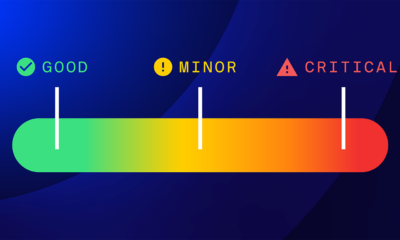SEO
Here’s Why You Should Prioritize Internal Linking in 2022

Internal linking features in most SEO strategies, but the reality is it’s rarely prioritized highly enough.
SEOs often focus on other tactics while failing to realize the true potential that internal linking offers to move the needle on keyword rankings.
My view on this is that SEOs are missing a trick. After all, an effective internal linking strategy has the potential to make a difference.
In this guide, you’ll learn the following:
Looking to learn the basics of internal linking?
Effective internal linking provides a wide range of technical benefits, from helping Google discover your new content to ensuring all of your pages are crawled frequently by Googlebot. In my opinion, the most fruitful value of internal linking is its ability to distribute PageRank. This is an attribute of internal linking that is overlooked all too often.
Building a strong backlink profile is critical in directing PageRank to your website. But as SEOs, we should not stop there. The great thing about internal links is that you can control the target location of the link itself. This allows you to directly pass on that essential link equity from your pages that receive the most links to those that receive the least.
One tough reality of link building is that webmasters rarely link to pages with transactional intent, such as a sales or product page. Most backlinks will typically point toward the homepage or an informational page (e.g., a report). Internal links are crucial in bridging the gap and ensuring your transactional pages gain that crucial boost in authority.
Editor’s Note
Here at Ahrefs, we call this process of “bridging the gap” with internal links the Middleman Method. You can see how it works below and learn more about this SEO strategy here.


Now that we’ve established the importance of internal linking, let’s go through a few techniques, tips, and tricks to implement it effectively.
Link within the main content where relevant
Internal links within the primary content of a page, in my opinion, offer the most value from a PageRank perspective.
This is as Google’s behavior is likely similar to that of the users’ when it comes to prioritizing the primary content of a page. Users are typically more engaged with the main content and are, therefore, more likely to click on a link that sits within the main content.
As a result, Google almost certainly applies a stronger weighting to these links, as indicated by its “Reasonable Surfer” patent.

What’s more, these internal links sit in the heart of the page and are surrounded by hyper-relevant, keyword-rich content that Google will use as a signal to understand the context.
Include important links within the site navigation
Links within the header navigation are also incredibly useful for passing on PageRank. They may not be as strong at passing contextual authority as links within the primary content. But they sit on every page of the site—and that makes them valuable. They also sit right at the top of the page.
This means Google is more likely to prioritize these links compared to the footer navigation, for example.
While not as powerful as the header navigation, the footer navigation should not be underestimated. Despite sitting in a less-attractive location, the footer navigation, again, sits on every page, making the links there worthwhile.
Notably, some companies have strict approval processes. In such cases, you may find less resistance in adding internal links to the footer navigation compared to the header navigation, so this may be the perfect short-term solution for you.
Utilize breadcrumbs logically
In my opinion, breadcrumbs are the single most underutilized form of internal linking. They not only make it extremely easy for users to navigate the site, but they are also incredibly powerful at passing on PageRank.
Don’t just take it from me. Here’s a tweet from Google’s very own Gary Illyes, who says that Google likes breadcrumbs and uses them for PageRank computation.
We likes them. We treat them as normal links in e.g. PageRank computation
— Gary 鯨理/경리 Illyes (@methode) June 22, 2017
As we already discussed, many SEOs believe the higher up a link on a page, the heavier the weight of PageRank that gets passed via the link. Breadcrumbs typically sit right at the top of every page. Thus, it’s clear why they hold so much value in passing on authority.
Furthermore, breadcrumbs also reflect the structure of the site. As a result, your most important pages, which sit high up within the site architecture, will be internally linked to very frequently via the breadcrumbs.
TIP
Don’t forget to implement breadcrumb Schema to ensure Google fully understands your breadcrumbs and that you’re eligible for rich results.
Internally link to your most valuable content
It’s usually hard to attract links to your most valuable content because of its commercial nature. Remember: To bridge this gap, it’s critical to link from those pages that hold strong authority to the valuable pages that drive your business revenue.
You can find relevant, authoritative pages to internally link from for free using Ahrefs’ Site Explorer with a free Ahrefs Webmaster Tools account. Here’s how:
- Paste your domain into Site Explorer
- Go to the Best by links report
- Look for relevant pages to internally link from
For example, let’s say the team at Ahrefs launched a brand-new keyword tool and wanted to boost authority to its landing page. Using this report, we can see several relevant pages with lots of referring domains that will be perfect for adding an internal link.

Utilize contextually relevant anchor texts to establish topical relevance
Earlier on, I mentioned Google reads the surrounding content of a link as a signal for the context. Further to this, the anchor text of a link provides an even stronger signal for context.
Anchor texts should be:
- Descriptive
- Topically relevant
- Keyword-rich
- Succinct
- Natural
Generic anchor texts, such as “click here,” provide minimal value, as they do not indicate to Google what the linked-to page is about. Keeping your anchor texts descriptive and relevant will ensure you are passing on the most PageRank. This signal also stems from Google’s “Reasonable Surfer” patent.

You can find contextual internal linking opportunities that already exist on your site for free using Ahrefs’ Site Audit. Here’s how:
- Sign up for a free Ahrefs Webmaster Tools account
- Crawl your site with Site Audit
- Go to the Link Opportunities tool
For example, if we do this for the Ahrefs blog, we can see a contextual internal link opportunity from our SEO glossary to our meta robots guide.

Sidenote.
If you provide a link via an image, Google will treat the alt text as the anchor text.
Regularly audit internal links for errors
Technical errors within your internal linking could be causing PageRank “leakage.” For example, every time you link to a URL that results in a 404 status (page not found), you could be directing some of your link equity down the drain.
Google assigns a set amount of PageRank to be distributed from each page (regardless of the number of internal links). So with each link that you add to a page, you’ll be slightly reducing the value passed on via the links that already exist.
But as long as you are not excessively adding links, this won’t be a major cause for concern. It’s simply another reason why minimizing technical errors remains crucial. Not only are you making sure both Google and your users are having the best experience, but your site will also become more efficient at passing on PageRank.
Don’t forget to utilize Site Audit (what I showed you earlier). This tool is perfect for diagnosing a wide range of technical issues, including those related to internal links.
Once set up:
- Head to the Link Explorer tool
- Select the “Internal” drop-down filter
- Filter by each of the errors one at a time
For example, if we filter for internal links “to not found” on the Ahrefs blog, we see 143 internal links to dead pages that should be removed.

Final thoughts
The best thing about this approach to internal linking is it’s not a complex theory (once you understand how PageRank works, of course). It also doesn’t take a huge amount of time to get started.
Here are my key takeaways:
- Internally link from your most authoritative content to the pages that drive revenue
- Breadcrumbs are incredibly powerful and completely underestimated
- When you think of PageRank, think about not only backlinks but also internal links
Have any questions? Will you be reshaping your approach to prioritize internal linking? Ping me on Twitter and let me know.
SEO
brightonSEO Live Blog

Hello everyone. It’s April again, so I’m back in Brighton for another two days of Being the introvert I am, my idea of fun isn’t hanging around our booth all day explaining we’ve run out of t-shirts (seriously, you need to be fast if you want swag!). So I decided to do something useful and live-blog the event instead.
Follow below for talk takeaways and (very) mildly humorous commentary. sun, sea, and SEO!
SEO
Google Further Postpones Third-Party Cookie Deprecation In Chrome

Google has again delayed its plan to phase out third-party cookies in the Chrome web browser. The latest postponement comes after ongoing challenges in reconciling feedback from industry stakeholders and regulators.
The announcement was made in Google and the UK’s Competition and Markets Authority (CMA) joint quarterly report on the Privacy Sandbox initiative, scheduled for release on April 26.
Chrome’s Third-Party Cookie Phaseout Pushed To 2025
Google states it “will not complete third-party cookie deprecation during the second half of Q4” this year as planned.
Instead, the tech giant aims to begin deprecating third-party cookies in Chrome “starting early next year,” assuming an agreement can be reached with the CMA and the UK’s Information Commissioner’s Office (ICO).
The statement reads:
“We recognize that there are ongoing challenges related to reconciling divergent feedback from the industry, regulators and developers, and will continue to engage closely with the entire ecosystem. It’s also critical that the CMA has sufficient time to review all evidence, including results from industry tests, which the CMA has asked market participants to provide by the end of June.”
Continued Engagement With Regulators
Google reiterated its commitment to “engaging closely with the CMA and ICO” throughout the process and hopes to conclude discussions this year.
This marks the third delay to Google’s plan to deprecate third-party cookies, initially aiming for a Q3 2023 phaseout before pushing it back to late 2024.
The postponements reflect the challenges in transitioning away from cross-site user tracking while balancing privacy and advertiser interests.
Transition Period & Impact
In January, Chrome began restricting third-party cookie access for 1% of users globally. This percentage was expected to gradually increase until 100% of users were covered by Q3 2024.
However, the latest delay gives websites and services more time to migrate away from third-party cookie dependencies through Google’s limited “deprecation trials” program.
The trials offer temporary cookie access extensions until December 27, 2024, for non-advertising use cases that can demonstrate direct user impact and functional breakage.
While easing the transition, the trials have strict eligibility rules. Advertising-related services are ineligible, and origins matching known ad-related domains are rejected.
Google states the program aims to address functional issues rather than relieve general data collection inconveniences.
Publisher & Advertiser Implications
The repeated delays highlight the potential disruption for digital publishers and advertisers relying on third-party cookie tracking.
Industry groups have raised concerns that restricting cross-site tracking could push websites toward more opaque privacy-invasive practices.
However, privacy advocates view the phaseout as crucial in preventing covert user profiling across the web.
With the latest postponement, all parties have more time to prepare for the eventual loss of third-party cookies and adopt Google’s proposed Privacy Sandbox APIs as replacements.
Featured Image: Novikov Aleksey/Shutterstock
SEO
How To Write ChatGPT Prompts To Get The Best Results

ChatGPT is a game changer in the field of SEO. This powerful language model can generate human-like content, making it an invaluable tool for SEO professionals.
However, the prompts you provide largely determine the quality of the output.
To unlock the full potential of ChatGPT and create content that resonates with your audience and search engines, writing effective prompts is crucial.
In this comprehensive guide, we’ll explore the art of writing prompts for ChatGPT, covering everything from basic techniques to advanced strategies for layering prompts and generating high-quality, SEO-friendly content.
Writing Prompts For ChatGPT
What Is A ChatGPT Prompt?
A ChatGPT prompt is an instruction or discussion topic a user provides for the ChatGPT AI model to respond to.
The prompt can be a question, statement, or any other stimulus to spark creativity, reflection, or engagement.
Users can use the prompt to generate ideas, share their thoughts, or start a conversation.
ChatGPT prompts are designed to be open-ended and can be customized based on the user’s preferences and interests.
How To Write Prompts For ChatGPT
Start by giving ChatGPT a writing prompt, such as, “Write a short story about a person who discovers they have a superpower.”
ChatGPT will then generate a response based on your prompt. Depending on the prompt’s complexity and the level of detail you requested, the answer may be a few sentences or several paragraphs long.
Use the ChatGPT-generated response as a starting point for your writing. You can take the ideas and concepts presented in the answer and expand upon them, adding your own unique spin to the story.
If you want to generate additional ideas, try asking ChatGPT follow-up questions related to your original prompt.
For example, you could ask, “What challenges might the person face in exploring their newfound superpower?” Or, “How might the person’s relationships with others be affected by their superpower?”
Remember that ChatGPT’s answers are generated by artificial intelligence and may not always be perfect or exactly what you want.
However, they can still be a great source of inspiration and help you start writing.
Must-Have GPTs Assistant
I recommend installing the WebBrowser Assistant created by the OpenAI Team. This tool allows you to add relevant Bing results to your ChatGPT prompts.
This assistant adds the first web results to your ChatGPT prompts for more accurate and up-to-date conversations.
It is very easy to install in only two clicks. (Click on Start Chat.)
For example, if I ask, “Who is Vincent Terrasi?,” ChatGPT has no answer.
With WebBrower Assistant, the assistant creates a new prompt with the first Bing results, and now ChatGPT knows who Vincent Terrasi is.
 Screenshot from ChatGPT, March 2023
Screenshot from ChatGPT, March 2023You can test other GPT assistants available in the GPTs search engine if you want to use Google results.
Master Reverse Prompt Engineering
ChatGPT can be an excellent tool for reverse engineering prompts because it generates natural and engaging responses to any given input.
By analyzing the prompts generated by ChatGPT, it is possible to gain insight into the model’s underlying thought processes and decision-making strategies.
One key benefit of using ChatGPT to reverse engineer prompts is that the model is highly transparent in its decision-making.
This means that the reasoning and logic behind each response can be traced, making it easier to understand how the model arrives at its conclusions.
Once you’ve done this a few times for different types of content, you’ll gain insight into crafting more effective prompts.
Prepare Your ChatGPT For Generating Prompts
First, activate the reverse prompt engineering.
- Type the following prompt: “Enable Reverse Prompt Engineering? By Reverse Prompt Engineering I mean creating a prompt from a given text.”
 Screenshot from ChatGPT, March 2023
Screenshot from ChatGPT, March 2023ChatGPT is now ready to generate your prompt. You can test the product description in a new chatbot session and evaluate the generated prompt.
- Type: “Create a very technical reverse prompt engineering template for a product description about iPhone 11.”
 Screenshot from ChatGPT, March 2023
Screenshot from ChatGPT, March 2023The result is amazing. You can test with a full text that you want to reproduce. Here is an example of a prompt for selling a Kindle on Amazon.
- Type: “Reverse Prompt engineer the following {product), capture the writing style and the length of the text :
product =”
 Screenshot from ChatGPT, March 2023
Screenshot from ChatGPT, March 2023I tested it on an SEJ blog post. Enjoy the analysis – it is excellent.
- Type: “Reverse Prompt engineer the following {text}, capture the tone and writing style of the {text} to include in the prompt :
text = all text coming from https://www.searchenginejournal.com/google-bard-training-data/478941/”
 Screenshot from ChatGPT, March 2023
Screenshot from ChatGPT, March 2023But be careful not to use ChatGPT to generate your texts. It is just a personal assistant.
Go Deeper
Prompts and examples for SEO:
- Keyword research and content ideas prompt: “Provide a list of 20 long-tail keyword ideas related to ‘local SEO strategies’ along with brief content topic descriptions for each keyword.”
- Optimizing content for featured snippets prompt: “Write a 40-50 word paragraph optimized for the query ‘what is the featured snippet in Google search’ that could potentially earn the featured snippet.”
- Creating meta descriptions prompt: “Draft a compelling meta description for the following blog post title: ’10 Technical SEO Factors You Can’t Ignore in 2024′.”
Important Considerations:
- Always Fact-Check: While ChatGPT can be a helpful tool, it’s crucial to remember that it may generate inaccurate or fabricated information. Always verify any facts, statistics, or quotes generated by ChatGPT before incorporating them into your content.
- Maintain Control and Creativity: Use ChatGPT as a tool to assist your writing, not replace it. Don’t rely on it to do your thinking or create content from scratch. Your unique perspective and creativity are essential for producing high-quality, engaging content.
- Iteration is Key: Refine and revise the outputs generated by ChatGPT to ensure they align with your voice, style, and intended message.
Additional Prompts for Rewording and SEO:
– Rewrite this sentence to be more concise and impactful.
– Suggest alternative phrasing for this section to improve clarity.
– Identify opportunities to incorporate relevant internal and external links.
– Analyze the keyword density and suggest improvements for better SEO.
Remember, while ChatGPT can be a valuable tool, it’s essential to use it responsibly and maintain control over your content creation process.
Experiment And Refine Your Prompting Techniques
Writing effective prompts for ChatGPT is an essential skill for any SEO professional who wants to harness the power of AI-generated content.
Hopefully, the insights and examples shared in this article can inspire you and help guide you to crafting stronger prompts that yield high-quality content.
Remember to experiment with layering prompts, iterating on the output, and continually refining your prompting techniques.
This will help you stay ahead of the curve in the ever-changing world of SEO.
More resources:
Featured Image: Tapati Rinchumrus/Shutterstock
-

 PPC6 days ago
PPC6 days ago19 Best SEO Tools in 2024 (For Every Use Case)
-

 MARKETING7 days ago
MARKETING7 days agoEcommerce evolution: Blurring the lines between B2B and B2C
-
SEARCHENGINES5 days ago
Daily Search Forum Recap: April 19, 2024
-
SEARCHENGINES6 days ago
Daily Search Forum Recap: April 18, 2024
-

 WORDPRESS6 days ago
WORDPRESS6 days agoHow to Make $5000 of Passive Income Every Month in WordPress
-

 SEO7 days ago
SEO7 days ago2024 WordPress Vulnerability Report Shows Errors Sites Keep Making
-

 WORDPRESS7 days ago
WORDPRESS7 days ago10 Amazing WordPress Design Resouces – WordPress.com News
-

 SEO6 days ago
SEO6 days ago25 WordPress Alternatives Best For SEO
















You must be logged in to post a comment Login